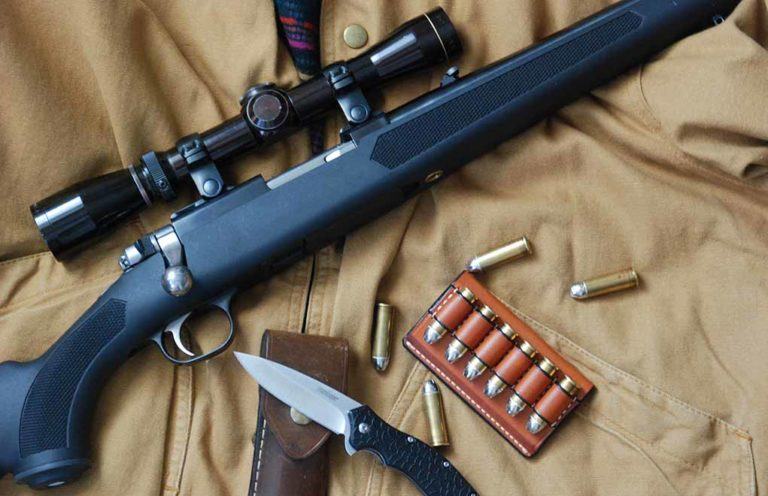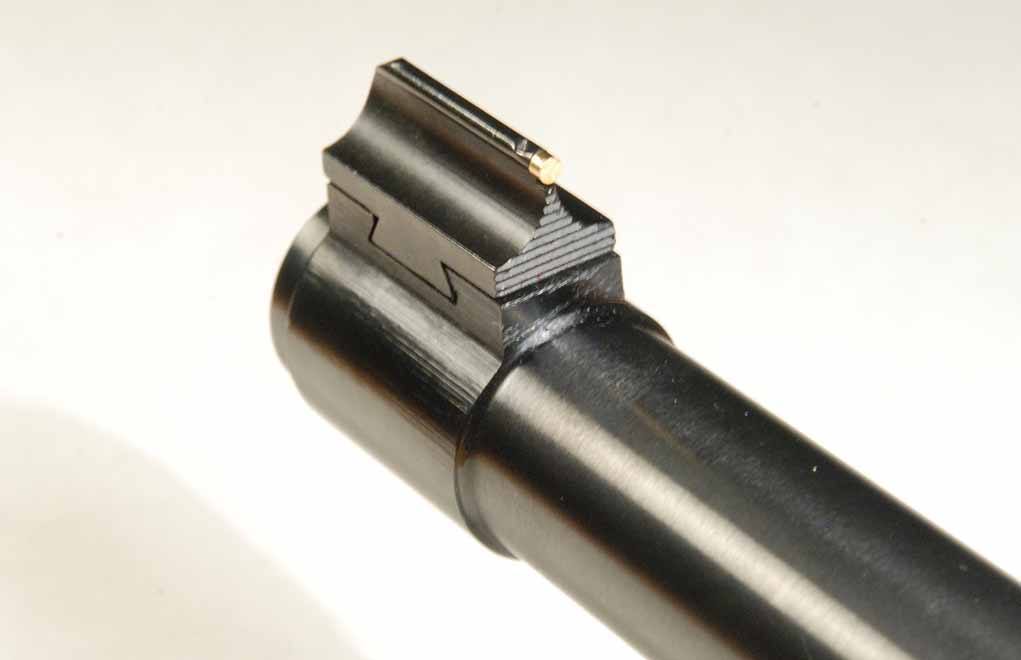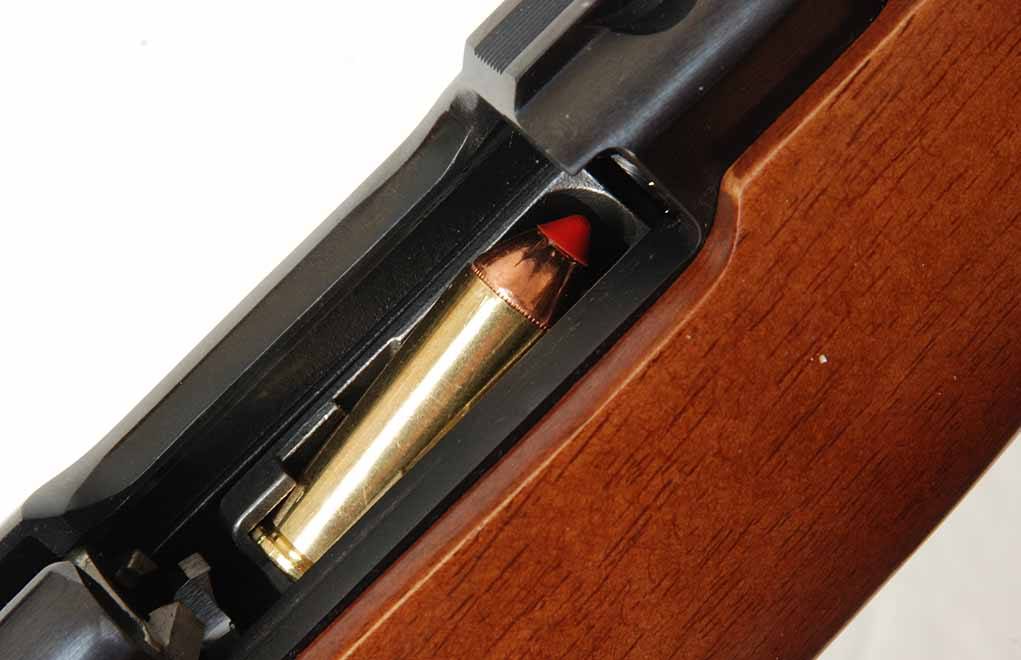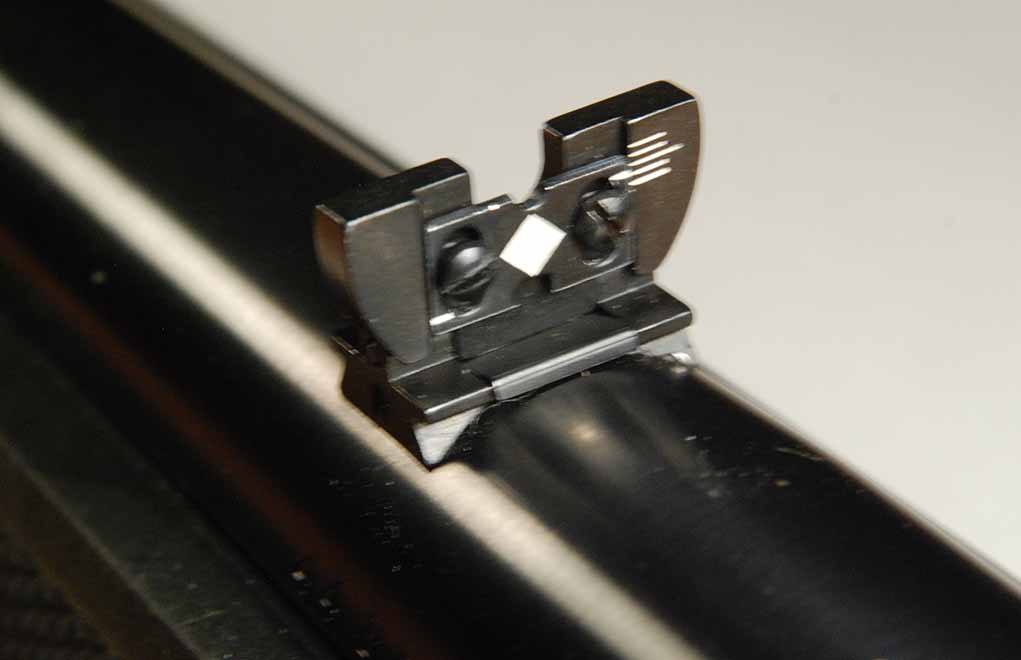
Ruger’s bolt-action .44 Magnum Rifle, the 77/44, has all features to make it a modern-day classic.
What Sets The 77/44 Apart From Other .44 Magnum Rifles:
- Receiver has milled notches that permit the attachment of proprietary Ruger rings.
- Comes equipped with a set of very good iron sights — the rear folding and fully adjustable.
- Utilizes a flush-fitting, detachable rotary magazine that holds four rounds.
- Boasts a three-position wing-type safety located just behind the root of the bolt handle.
- Weighs only 6 pounds and measures in at 18.5 inches in overall length.
It’s hard to explain what makes a rifle so appealing, but there can be no doubt that esthetics are an important consideration when selections are made. To me, the quintessential favorites are the lever-action Winchester Model 94 and the bolt-action Model 70. However, any classic bolt-action model that is complete with sights mounted on the barrel is appealing. I have scopes on most of my rifles, but even so iron sights are a real plus for any rifle that I have to depend on in remote areas.

Not long ago, I read an article written by one of my favorite authors on selecting the walkabout rifle. After giving the general characteristics about portability, power and availability of ammunition, he discussed sights. The conclusion was that a scope might not be attached and that the open sights would be sufficient.
Find Out More About Ruger Firearms
Moreover, after discussing several rifles as possibilities, the selection was a Ruger, either the 77/44 or 77/357. That author’s preference was for the latter, but mine is for the former so I am suddenly the proud owner of a Ruger 77/44.

The Ruger 77 Series of rotary magazine rifles was introduced in 1983 with the .22 LR version. I got one in the first or second year of production and thus started my devotion to the rifles. Dual locking lugs located on the rear section of the two-piece bolt of the 77/22 mate in recesses in the steel receiver, making the action of the rifle very robust for a rimfire.
As a result, the rifle was subsequently offered as the 77/22M in .22 WMR, 77/17 in .17 HMR and 77/22H in .22 Hornet calibers. In 1998, the slightly longer action of the .22 Hornet was modified to accommodate the .44 Magnum, and thus was formed the 77/44. Later, the version in .357 Magnum came along. From the beginning, the .44 and .357 versions wore iron sights in keeping with their intended use as short- to moderate-range hunting arms.
A Welcomed Homecoming

In late 2016 came an email indicating that most models of the rotary magazine rifles were being discontinued. This was unwelcome news to those of us who are very fond of the series, but about a year, several models were reintroduced, including the 77/44. Currently, four versions of the 77/44 are listed on Ruger’s website. These include two that have blued steel barrels and actions with either walnut (MSRP $999) or black (MSRP $939) synthetic stocks.
Also available are versions that feature stainless-steel with either black or a camo synthetic stock, both with MSRP of $999. Barrel length on the Ruger 77/44 is 18.5 inches and the .44 Magnum rifle weighs approximately 6 pounds. Most of the walnut-stocked specimens that I’ve seen have very attractive wood and crisp checkering.

Several clever and functional features are to be found on the Ruger 77/44.
- First, the receiver has milled notches that permit the attachment of proprietary Ruger rings and, therefore, no separate bases are needed in order to attach a scope.
- Second, all versions of the 77/44 are equipped as they should be with a set of very good iron sights.
- Third, the .44 Magnum rifle utilizes a flush-fitting, detachable rotary magazine that holds four rounds — making it a five-shot rifle.
- Fourth, a three-position wing-type safety is located just behind the root of the bolt handle. If the safety lever is moved fully to the rear, it forces a pin into a recess in the bolt handle, which prevents the bolt from being opened. Therefore, when the safety is in that position, the bolt cannot be opened and the rifle cannot be fired. Moving the safety to the mid position allows the spring-loaded locking pin to move backward out of the recess in the bolt handle, permitting the bolt to be opened, but the rifle cannot be fired. When the safety lever is in the forward position, the bolt can be opened and the rifle can be fired.
Options, Through Ammo
But, “pretty is as pretty does” goes the old saying. When it comes to a .44 Magnum rifle, the “does” is enhanced by a very wide choice of factory ammunition. All of the major loading companies offer .44 Magnum loads that feature 240-grain jacketed bullets that are either soft or hollow-points. Some of the sources are Remington, Winchester, Federal, Hornady, CCI, PMC, Magtech, Buffalo Bore, Armscor, Fiocchi, Swift and others.

It would require a long article just to give the details about the various .44 Magnum loads that are available. However, there are a great many choices other than those with the typical 240-grain bullets. For example, Hornady offers a load having a 240-grain XTP bullet, but it also loads with 200- and 300-grain XTP bullets.
One of the most unusual .44 Magnum loads is the 225-grain LEVERevolution from Hornady. It features the FTX bullet that has a flexible tip so it can be used in rifles having tubular magazines. From a rifle, the advertised velocity is 1,870 fps, giving a muzzle energy of 1,750 ft-lbs. From the 18.5 inch barrel of the Ruger 77/44, the velocity measured 1,768 fps. One of the interesting aspects of this round is that having a pointed bullet means that it retains velocity better than the typical hollow- and blunt-pointed bullets. However, this is not much of a factor at the relatively short ranges at which a .44 Magnum rifle is used.

The Winchester 240-grain jacketed soft-point gave a measured velocity of 1,722 fps. Sometimes, one hears criticism of the hollow-point bullets regarding penetration, but the soft-points usually avoid that problem. The issue of insufficient penetration can really be solved by use of some of the loads such as those from Buffalo Bore that utilize 270-grain Speer Gold Dot bullets.
For use where both penetration and expansion are required, it’s difficult to imagine a more effective round than that from Swift, which utilizes a 300-grain A-Frame bullet. Of the factory ammunition in .44 Magnum caliber that I’ve tested, the real screamer is the 180-grain soft point from Remington that gave a measured velocity of 2,244 fps from the Ruger 77/44. Of course, such a short, blunt bullet would lose velocity rapidly, but it should produce dramatic effects on predators. The point is that there are plenty of ammunition options to allow the shooter of a Ruger 77/44 to be equipped for many uses.

By any standard, the Ruger 77/44 is a trim, elegant little .44 Magnum rifle. When I obtained mine, I envisioned some uses of it for which I would rather not have the beautiful stock subjected. Accordingly, I immediately ordered a black composite factory replacement stock from Midway USA for the very reasonable price of $59.99. Now, I can configure the rifle with either wood or composite stock holding the blued barrel and action.
Editor's Note: This article originally appeared in the December 2018 issue of Gun Digest the Magazine.
Get More Ruger Info:
- Great Ruger Guns
- Ruger No. 1
- Ruger Precision Rifle
- Ruger Redhawk
- Ruger Super Redhawk
- Ruger Blackhawk
- Ruger Single Six
- Ruger 10/22
- Ruger LCR
- Ruger LCRx
- Ruger 77/22
- Ruger SR1911
- Ruger Hawkeye
- Ruger Mark IV
- Ruger SR-556
- Ruger LCP II
- Ruger American Magnum
- Ruger American Rifle
- Ruger Gunsite Scout Rifle
- Ruger SR-762
- Ruger Red Label
- Ruger SR40
- Ruger Single Nine
- Ruger P345

Next Step: Get your FREE Printable Target Pack
Enhance your shooting precision with our 62 MOA Targets, perfect for rifles and handguns. Crafted in collaboration with Storm Tactical for accuracy and versatility.
Subscribe to the Gun Digest email newsletter and get your downloadable target pack sent straight to your inbox. Stay updated with the latest firearms info in the industry.

![Best Concealed Carry Guns In 2025 [Field Tested] Wilson Combat EDC X9S 1](https://gundigest.com/wp-content/uploads/Wilson-Combat-EDC-X9S-1-324x160.jpg)


![Best 9mm Carbine: Affordable PCCs [Tested] Ruger Carbine Shooting](https://gundigest.com/wp-content/uploads/Ruger-Carbine-Shooting-100x70.jpg)
![Best AR-15: Top Options Available Today [Field Tested] Harrington and Richardson PSA XM177E2 feature](https://gundigest.com/wp-content/uploads/Harrington-and-Richardson-PSA-XM177E2-feature-100x70.jpg)
